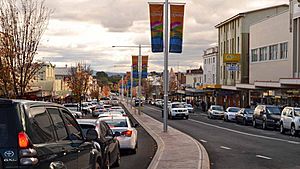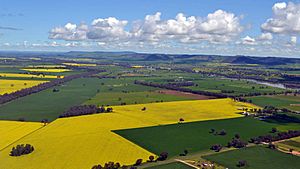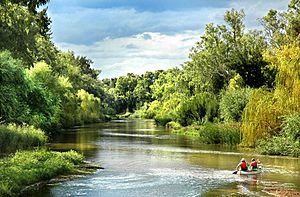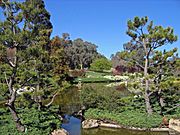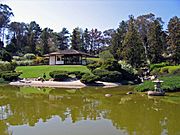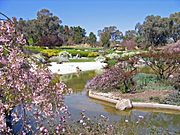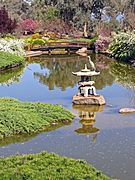Cowra facts for kids
Quick facts for kids CowraNew South Wales |
|||||||||
|---|---|---|---|---|---|---|---|---|---|
|
From top to bottom, left to right: Kendal Street divides the CBD; the Eastern entrance to the town, near Europa Park; Crops of canola creating fields of gold;Australia's World Peace Bell proudly housed in Cowra's Civic Square; and the Lachlan River which flows through the heart of the town
|
|||||||||
| Population | 9,863 (2016 census) | ||||||||
| Established | 1846 | ||||||||
| Gazetted | 1849 | ||||||||
| Postcode(s) | 2794 | ||||||||
| Elevation | 310 m (1,017 ft) | ||||||||
| Time zone | AEST (UTC+10) | ||||||||
| • Summer (DST) | AEDT (UTC+11) | ||||||||
| Location | |||||||||
| LGA(s) | Cowra Shire | ||||||||
| County | Forbes, Bathurst | ||||||||
| State electorate(s) | Cootamundra | ||||||||
| Federal Division(s) | Riverina | ||||||||
|
|||||||||
Cowra (/ˈkaʊrə/) is a small town in the Central West region of New South Wales, Australia. It is the largest population centre and the council seat for the Cowra Shire, with a population of 9,863.
Cowra is located approximately 310 m (1,017 ft) above sea level, on the banks of the Lachlan River, in the Lachlan Valley. By road it is approximately 310 km (193 mi) west of the state capital, Sydney, and 189 km (117 mi) north of the nation's capital, Canberra. The town is situated at the intersection of three state highways: the Mid-Western Highway, Olympic Highway, and the Lachlan Valley Way.
Cowra is included in the rainfall recorder and weather forecast region for the Central West Slopes and Plains division of the Bureau of Meteorology forecasts.
Contents
History
The first explorer, George William Evans, entered the Lachlan Valley in 1815. He named the area the Oxley Plains after his superior the surveyor-general, John Oxley. In 1817 he deemed the area "unfit for settlement". A military depot was established not long after at Soldiers Flat near present-day Billimari. Arthur Ranken and James Sloan, from Bathurst, were amongst the first white settlers on the Lachlan. They moved to the area in 1831.
The township of "Coura Rocks" had its beginnings in 1844. Around 1847, the township site became known as Cowra, and in 1849, was proclaimed a village.
In the 1850s many gold prospectors passed through headed for gold fields at Lambing Flat (Young) and Grenfell. The first school was established in 1857. The first bridge over the Lachlan River was built in 1870. Gold was discovered at Mount McDonald in the 1880s. The rail head, from Sydney, reached Cowra in 1886. Local government was granted in 1888. The first telephone exchange was established in 1901. The town water supply was established in 1909, the gasworks in 1912 and town supplied electricity was introduced in 1924.
Cowra hosts an annual Festival of International Understanding, featuring a parade, balloons for the kids and events showcasing a particular foreign culture.
Heritage listings
Cowra has a number of heritage-listed sites, including:
- Blayney–Harden railway: Lachlan River railway bridge, Cowra
- Blayney–Harden railway: Cowra railway station
- Evans Street: Cowra Prisoner of War Camp Site
According to the 2016 census of Population, there were 10,063 people in Cowra.
- Italian people made up 5% of the population.
- 85.2% of people were born in Australia. The next most common country of birth was England at 1.4%.
- 89.0% of people spoke only English at home.
- The most common responses for religion were Catholic 29.7%, Anglican 26.0% and No Religion 16.0%.
- Cowra has a higher than average unemployment rate. Presently at 8.2%
Climate
Cowra has a temperate climate, with average maximum temperatures ranging from 32 °C (90 °F) in summer to 14 °C (57 °F) in winter, while minimums range from 16 °C (61 °F)* to 2 °C (36 °F). Under the Köppen climate classification, Cowra has a Semi-arid climate (BSk) with Oceanic climate (Cfb) characteristics.
Cowra sits on the border zone between the cool, wet highlands of the Great Dividing Range and the hot, dry plains of Western New South Wales. As a result, Cowra experiences climate characteristics of both regions, with cold sub-zero temperatures, frequent frost and occasional snow in winter, and frequent 40+ °C temperatures in summer. Other towns that experience this 'border' climate are Gunnedah and Mudgee further north, Yass and Gundagai further south, Wangaratta in Victoria and Dalby in Queensland.
Rainfall is mild and distributed fairly evenly all year round, however it slightly peaks in summer with thunderstorms and again in winter with cold fronts. The average annual rainfall is 598.3 mm (24 in), while Cowra's wettest month on record was January 1984, with 371.0 mm (15 in) recorded. Extreme temperatures have ranged from 46.6 °C (116 °F) to −8.0 °C (18 °F). Cowra has 145.8 clear days on an annual basis.
| Climate data for Cowra Airport (1966-2015) | |||||||||||||
|---|---|---|---|---|---|---|---|---|---|---|---|---|---|
| Month | Jan | Feb | Mar | Apr | May | Jun | Jul | Aug | Sep | Oct | Nov | Dec | Year |
| Record high °C (°F) | 46.6 (115.9) |
44.2 (111.6) |
39.5 (103.1) |
36.0 (96.8) |
27.0 (80.6) |
24.0 (75.2) |
22.0 (71.6) |
34.4 (93.9) |
33.5 (92.3) |
36.7 (98.1) |
43.8 (110.8) |
41.8 (107.2) |
46.6 (115.9) |
| Mean daily maximum °C (°F) | 31.9 (89.4) |
30.7 (87.3) |
28.1 (82.6) |
23.6 (74.5) |
18.6 (65.5) |
14.7 (58.5) |
13.7 (56.7) |
15.5 (59.9) |
18.6 (65.5) |
22.7 (72.9) |
26.7 (80.1) |
30.2 (86.4) |
23.0 (73.4) |
| Mean daily minimum °C (°F) | 15.6 (60.1) |
15.6 (60.1) |
12.5 (54.5) |
8.3 (46.9) |
5.1 (41.2) |
3.1 (37.6) |
2.1 (35.8) |
2.8 (37.0) |
4.5 (40.1) |
7.0 (44.6) |
10.2 (50.4) |
13.1 (55.6) |
8.3 (46.9) |
| Record low °C (°F) | 5.0 (41.0) |
5.0 (41.0) |
0.6 (33.1) |
−3.0 (26.6) |
−5.0 (23.0) |
−5.5 (22.1) |
−8.0 (17.6) |
−6.0 (21.2) |
−3.0 (26.6) |
−2.0 (28.4) |
−2.0 (28.4) |
2.0 (35.6) |
−8.0 (17.6) |
| Average rainfall mm (inches) | 59.6 (2.35) |
52.9 (2.08) |
40.4 (1.59) |
42.8 (1.69) |
46.3 (1.82) |
40.5 (1.59) |
52.5 (2.07) |
47.8 (1.88) |
52.5 (2.07) |
56.3 (2.22) |
53.3 (2.10) |
53.4 (2.10) |
598.3 (23.56) |
| Average rainy days (≥ 0.2mm) | 6.5 | 5.7 | 5.8 | 5.5 | 7.6 | 9.4 | 11.0 | 10.2 | 9.1 | 8.2 | 7.8 | 6.5 | 93.3 |
| Average relative humidity (%) | 34 | 37 | 39 | 44 | 54 | 63 | 62 | 57 | 53 | 47 | 39 | 32 | 47 |
| Source: Bureau of Meteorology | |||||||||||||
Education
- Primary schools
- Cowra Public School
- Mulyan Public School
- Holman Place Public School
- St Raphael's Catholic School (K–6)
- Secondary schools
- Cowra High School (7–12)
- St Raphael's Catholic School (7–12)
Cowra also has a campus of the Western Institute of TAFE.
Media
Radio stations
Radio stations with transmitters located in or nearby to Cowra include:
AM:
- ABC Local Radio 549 AM
- 2LF 1350 AM
FM:
- Hit Network 105.9 FM
- Triple M – Central West 105.1 FM
- Roccy FM 99.5 FM
- ABC Classic FM 102.7 FM
- ABC Radio National 104.3 FM
- FM107.5 107.5 FM
- Triple J (2JJJ) 101.9 FM
Television
Cowra receives five free-to-air television networks and their affiliates which are relayed from Orange, and broadcast from nearby Mt Canobolas:
- ABC – ABC TV, ABC TV Plus/ABC Kids, ABC ME and ABC News
- SBS – SBS TV, SBS Viceland, SBS Food, NITV, SBS World Movies and SBS WorldWatch
- Seven Network – Seven, 7two, 7mate, 7Bravo, 7flix, ishop TV and Racing.com
- Southern Cross – 10 HD, 10 Bold, 10 Peach, 10 Shake and Sky News Regional
- WIN – 9HD, 9Gem, 9Go!, 9Life and Gold
- Local half-hour long news bulletins are broadcast by Seven and WIN but Southern Cross shows local news updates instead from its Hobart studios.
The local newspaper is the Cowra Guardian, published by Australian Community Media.
Viticulture
Viticulture is a significant industry in the Cowra area. The first vineyards were planted in the 1970s and were predominantly Chardonnay. Since this time, a range of varieties have had success, including Mourvedre and Tempranillo.
Retail
Cowra has a wide variety of retailers both large and small, including:
- Coles – supermarket
- Woolworths – supermarket
- Aldi – supermarket
- Bunnings Warehouse – hardware
- The Reject Shop – discount variety store
- Total Tools
Japanese War Cemetery
A cemetery was initially created holding the 231 prisoners who died in the Cowra Breakout and was tended by members of the Cowra RSL after World War II. The site is next to the Australian War Cemetery, which houses local servicemen, personnel who died in the area, and four of the guards of the Cowra breakout. There are also a few Indonesian prisoner graves of people who were detained by the Dutch authorities.
Formalisation of the site as an official war grave began in 1959 and the site opened as the Japanese War Cemetery on 22 November 1964. Eventually, 524 bodies were interred there, including civilian internees and all other Japanese combatants who were buried in other parts of Australia (since their graves were later moved there). Not all dead were Japanese nationals, but include 25 Taiwanese and 1 Korean (which at the time were colonies of Japan).
The cemetery is on Crown land owned by the New South Wales government under trusteeship of the Commonwealth War Graves Commission. Use of the land, was granted to Japan in 1963 on a payment-of-costs basis. In 1971, the Cowra Tourism Development decided to celebrate this link to Japan, and proposed a Japanese garden for the town. The Japanese government agreed to support this development as a sign of thanks for the respectful treatment of their war dead; the development also received funding from the Australian government and private entities.
Japanese Garden
Located 3 kilometres south of the war cemetery is the Cowra Japanese Garden and Cultural Centre. It was designed in 1977 by Ken Nakajima (1914–2000), a "world renowned architect" of Japanese gardens at the time. The first stage was opened in 1979, with a second stage opened in 1986. The gardens were designed in the style of the Edo period and are a komatsu ("small pine-tree") or strolling garden. The rocky hillside, manicured hedges, waterfalls and streams, and the two lakes provide a serene environment for a myriad of birdlife. Special features of the garden include a Bonsho Bell, a traditional Edo Cottage, an authentic open air Tea House and a Bonsai House. They are designed to show 'A Sense of Season' throughout the year as well as represetative landscape types of Japan. At five hectares (12 acres), the garden is the largest Japanese garden in the Southern Hemisphere. They were added to the National Trust Register in June 2013.
After cherry trees were planted in 1988, an annual Sakura Matsuri (cherry blossom festival) was first held in 1990 and is an event in Cowra's tourism calendar and is held in the gardens during September. The festival celebrates the birth of spring. Locals, Australian and international visitors alike have the opportunity to experience traditional elements of Japanese culture. Sakura at the Cowra Japanese Garden is celebrated annually when the cherry blossoms are at their peak.
Sport
The most popular sport in Cowra is rugby league. The local team, the Cowra Magpies, compete in the Peter McDonald Premiership, of which they are a part of the Group 10 Division.
Sporting clubs
- Cowra Magpies are a rugby league team playing in the Peter McDonald Premiership (Group 10) competition.
- Cowra Eagles are a rugby union team playing in the Central West Rugby Union competition.
- Cowra Blues are an Australian rules football team playing in the AFL Central West competition.
- Cowra Eagles are a soccer club playing in the Orange District Soccer Senior Men's (1st Grade) competition.
- Cowra Netball association play in State Age Championships competition.
- Cowra Squashed Frogs are a hockey team playing in the Western Division.
Population
| Historical population | ||
|---|---|---|
| Year | Pop. | ±% |
| 1921 | 3,716 | — |
| 1933 | 5,056 | +36.1% |
| 1947 | 5,473 | +8.2% |
| 1954 | 6,097 | +11.4% |
| 1961 | 6,288 | +3.1% |
| 1966 | 7,076 | +12.5% |
| 1971 | 7,295 | +3.1% |
| 1976 | 7,734 | +6.0% |
| 1981 | 7,900 | +2.1% |
| 1986 | 8,207 | +3.9% |
| 1991 | 8,422 | +2.6% |
| 1996 | 8,544 | +1.4% |
| 2001 | 8,691 | +1.7% |
| 2006 | 8,430 | −3.0% |
| 2011 | 8,107 | −3.8% |
| 2016 | 8,225 | +1.5% |
| 2021 | 8,254 | +0.4% |
| Source: Australian Bureau of Statistics data. | ||
Notable people
- Ellie Carpenter (born 2000), soccer player who plays for Olympique Lyon and for the Australia national team


